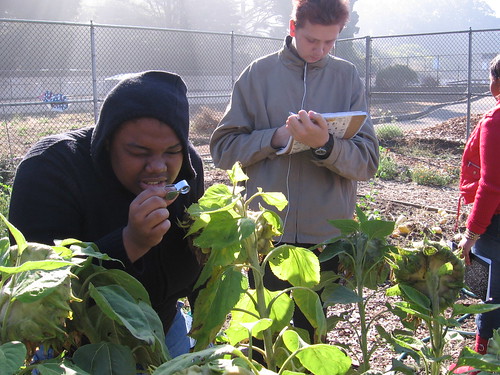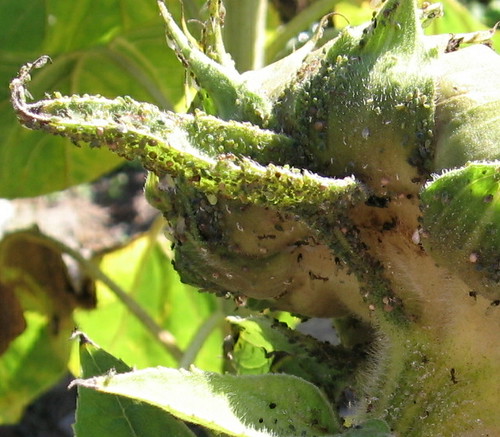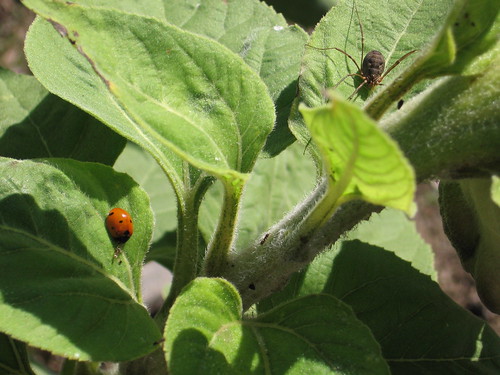 Yesterday we went on a garden safari in search of fierce predators in their natural habitat. It was just like a nature show. The students used their 5 senses, hand lenses, and Mac's Field Guide to California garden bugs as their only guide.
Yesterday we went on a garden safari in search of fierce predators in their natural habitat. It was just like a nature show. The students used their 5 senses, hand lenses, and Mac's Field Guide to California garden bugs as their only guide.We had to be very quiet, patient, and observant. At first the garden seemed empty. We thought there was nothing to see. But as we moved in, and got right up close to the plants, a whole world of action, aggression, predation and pollination unfolded!
 We identified insects and other creatures by the number of legs and the type of wings they have. Then, we tried to figure out what they were up to based on where we found them (like crawling on a plant leaf or flying near a flower).
We identified insects and other creatures by the number of legs and the type of wings they have. Then, we tried to figure out what they were up to based on where we found them (like crawling on a plant leaf or flying near a flower).We saw these aphids (bad for the garden - they eat our crops!) snacking on a sunflower.
 Then, we noticed this ladybug and daddy long legs hanging around near by. The ladybug looks hungry! (good for the garden - predators who eat insects that eat our crops)
Then, we noticed this ladybug and daddy long legs hanging around near by. The ladybug looks hungry! (good for the garden - predators who eat insects that eat our crops) Finally, Luis and Jimmy noticed this huge bug. It had the looks of a fierce predator (seriously, it's like an inch long!), but Mr. Alexander identified it as a Squash Bug, an eater of plant juices and destroyer of crops, according to Mac's Field Guide. What do you think?
Finally, Luis and Jimmy noticed this huge bug. It had the looks of a fierce predator (seriously, it's like an inch long!), but Mr. Alexander identified it as a Squash Bug, an eater of plant juices and destroyer of crops, according to Mac's Field Guide. What do you think? In the end, we decided that all these interdependent relationships between bugs and plants are very important to the garden. Insects need plants for food, insects need other insects for food, and plants need insects for pollination and therefore to reproduce and keep their species alive!
In the end, we decided that all these interdependent relationships between bugs and plants are very important to the garden. Insects need plants for food, insects need other insects for food, and plants need insects for pollination and therefore to reproduce and keep their species alive!We marveled at the diversity of critters in our small, urban garden. Wouldn't it be a tragedy if we wiped it all out by spraying pesticides? The ladybugs will do a great job if we just give them some habitat! This approach is called Integrated Pest Management.
If you'd like to use our bug safari worksheet, contact us!
beneficial bugs integrated pest management









3 comments:
My dad, the bug guy, says "I think the bug "hemiptera" was in the seed bug family, 'lygidae,' they eat seed, I guess."
and yes, the swallowtail butterfly in the previous post is a photo I took in the JJSE/SMSE garden!
The big bug is one of the many assassin bugs. This particular model is the wheel bug, so named for the big wheel-like ridge on the back, behind the head. Seen from the side, it looks a lot like a wheel due to its rounded shape. The spikey protrusions along the crest make it look like a gear wheel or saw. The squash bug is the same as the stink bug which, at least the gray-brown version, is colored just like the wheel bug. They look similar except that the squash bugs have the more traditional shield shape and are shorter, squatter bugs. Their heads don't stick out from their bodies like the assassin bug and their proboscis is straight as a needle and held flat against their undersides. The wheel bug has longer, thicker legs that hold it high off the ground, a longer, thinner body, and a much thicker, curved proboscis. The reason for these differences in body types is that the squash bug, as Mr. Anderson said, uses it's needle-like proboscis to stab into and suck the juices from plants. But the wheel bug you have pictured uses its longer legs to stand over bugs like the squash bug and uses its big, thick proboscis to stab into them and drink their juices. So yes, the squash bug is a pest but they rarely cause any significant damage unless they are in huge numbers, which usually only occurs where pesticides have wiped out the natural predators like the wheel bug, lady bug, lacewings, spiders and mantises. The pests always return faster than the predators. The only problem that might occur with a wheel bug is being bitten by one. And that is indeed a rare occurrance resulting from either an accident on the part of the bug or mishandling by a person. Left alone, they are a true asset to any garden. Both the squash bug and wheel bug are in the class hemiptera or half-wing. They can be easily recognized by the little shield-shaped area formed by the lines between and at the top of the wings.
What a great resource your readers are...thanks for your efforts.
Post a Comment